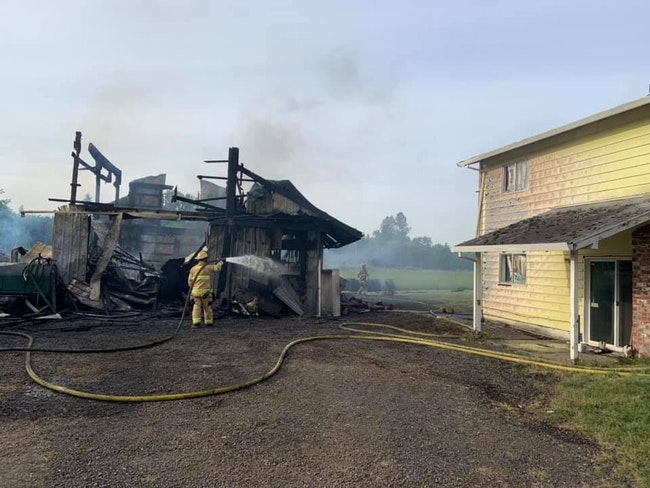 The barn that burned near Banks on Tuesday, May 11. Photo: Banks Fire District
The barn that burned near Banks on Tuesday, May 11. Photo: Banks Fire District
Banks Fire District 13 and several neighboring fire agencies fought a fire near Banks that destroyed a barn and caused significant damage to a nearby home on Tuesday evening.
Banks Fire District was first dispatched to reports of a fire in the Wilkesboro community near the intersection of Aerts Road and Wilkesboro Road just outside of Banks around 5:15 p.m. Tuesday, May 11, according to Banks Fire spokesperson Mitch Ward.
The two-story barn was engulfed in flames when crews arrived, and caused significant heat damage to a house on the property located next to the barn. No animals or people were injured in the blaze, which is believed to have been caused by a burn pile behind the barn used over the weekend that may have been reignited by wind. Embers were likely carried on the wind into the open barn windows, and found their way to the loft, which contained dry hay.
The cause remains under an official investigation to confirm the exact cause, according to Ward.
“Banks Fire would like to remind everyone that when burning outdoors always monitor your fire with a source of water. Always thoroughly extinguish your fire before leaving it. Fires can re-ignite even days later if not extinguished thoroughly, especially with the winds we are having,” Ward said.
Banks Fire was assisted by Tualatin Valley Fire & Rescue, Forest Grove Fire & Rescue, and the Cornelius Fire Department.
The Oregon Department of Forestry cautioned against burning debris in a May 10 press release due to warm weather and conditions.
“This year’s warm and dry conditions have already caused fires to burn many acres quickly. Rather than burning yard debris, you can help prevent wildfires by chipping or recycling it,” the agency said, and offered the following advice if burning is a necessity:
–Call before you burn – Burning regulations vary by location depending on the weather and fuel conditions. If you are planning to burn, check with your local Oregon Department of Forestry district, fire protective association, or air protection authority to learn about current burning restrictions or regulations, and if you need a permit.
–Know the weather – Never burn on dry or windy days, because fires can spread out of control more easily.
–Clear a 10-foot buffer – Make sure there are no tree branches or power lines above or fuels around your pile.
–Keep burn piles small – Large burn piles can cast hot embers long distances. Use small piles, maximum of four feet by four feet. Add only a little debris as the pile burns, to keep it small.
–Always have water and fire tools nearby – When burning, have a water hose on and ready or a bucket of water, and shovel and dirt to put out the fire. Drown the pile with water, stir the coals, and drown again, repeating until the fire is out cold.
–Stay with the fire until it is out cold – State laws requires monitoring of debris burn from start to finish until it is out cold. This law is intended to ensure sparks or embers that jump from the fire can be put out quickly. Recheck burn piles. They can retain heat for several weeks and restart when the weather warms up and winds blow.
–Never use gasoline or other flammable or combustible liquids to start or speed up your fire. Every year, about 60 percent of the Oregon Burn Center cases are from yard debris burning.
–Only burn yard debris – State laws prohibit burning materials in the open that create dense smoke or noxious odors.
–Costs of run-away debris burns– State law requires the proper clearing, building, attending and extinguishing of open fires all year. Citations can cost $2,000. If your debris burn spreads out of control, you will have to pay for putting the fire out, and likely the damage to your neighbors’ properties. This can be extremely expensive

Chas Hundley is the editor of the Banks Post and sister news publications the Gales Creek Journal and the Salmonberry Magazine. He grew up in Gales Creek and has a cat.






